Let’s take a look back at the late 1960s and early 70s, a period that was among the most tumultuous in America’s history. Assassinations, civil unrest, a seemingly never-ending war and (most importantly to this essay) an ever-present racial tension were constants in what The Wall Street Journal columnist David Roth called “that Nixon-era sense of apocalypse-by-the-end-of-the-week.” That feeling was manifested no more overtly than in the fiction of the period, which teemed with apocalyptic racial fervor conflated into science—or at least speculative—fiction territory.
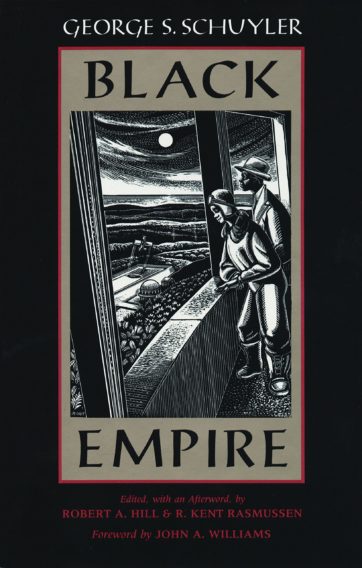 Racially motivated science fiction? It definitely exists, being a trope that stretches back to the late 1930s, when the novellas THE BLACK INTERNATIONALE and BLACK EMPIRE were serialized in Courier magazine by George Schuyler (writing as “Samuel L. Brooks”). They describe an African utopia founded by a wealthy black man who establishes a religion and an air force of his own, and utilizes a number of technological marvels (such as an early form of solar power) in a quest to combat white supremacy. Although less apocalyptic than the 1960s and 70s-era publications I’ll be discussing, Schuyler’s works form a direct link to the black-uprisings-spearheaded-by-well-funded-revolutionaries narratives that figure in THE COMING SELF-DESTRUCTION OF THE U.S.A. by Alan Seymour and PLAN B by Chester Himes.
Racially motivated science fiction? It definitely exists, being a trope that stretches back to the late 1930s, when the novellas THE BLACK INTERNATIONALE and BLACK EMPIRE were serialized in Courier magazine by George Schuyler (writing as “Samuel L. Brooks”). They describe an African utopia founded by a wealthy black man who establishes a religion and an air force of his own, and utilizes a number of technological marvels (such as an early form of solar power) in a quest to combat white supremacy. Although less apocalyptic than the 1960s and 70s-era publications I’ll be discussing, Schuyler’s works form a direct link to the black-uprisings-spearheaded-by-well-funded-revolutionaries narratives that figure in THE COMING SELF-DESTRUCTION OF THE U.S.A. by Alan Seymour and PLAN B by Chester Himes.
Before examining those novels, however, I’ll profile another racially powered science fiction novel: 1964’s FARNHAM’S FREEHOLD by Robert A. Heinlein. 1964 was the year of the Harlem riots, which may have played a part in the conception of the novel, about six mostly white suburbanites in a nuclear fallout shelter who are somehow plunged into an alternate universe run by cannibalistic African Americans. The novel sold quite poorly, and no wonder: it contains an obnoxious know-it-all old guy protagonist of a type that tended to recur in Heinlein’s post-1960 novels, and views on race relations that are questionable, to say the least (the famously libertarian-minded Heinlein probably wasn’t the ideal person to write a sci-fi novel about race relations), but it seems to me that the novel’s muted reception was most likely due to the inference that a black run America might actually be (cannibalism aside) preferable to the one in which its initial readers were living.
1964 also saw the debut of THE SLAVE, a one-act play by Amiri Baraka (then known as LeRoi Jones) that involves a white man and his wife trapped in their home with a black militant while a race war, initiated by the latter, rages outside. Nothing much is settled, much less resolved, in this bleak account that potently foreshadows the decade’s later years in terms of reality and fiction.
What followed was the five day Watts, CA riots of August 1965, an event that’s been immortalized in literature both high (POST OFFICE by Charles Bukowski) and low (WATTS…THE DIFFERENCE by Ed Wood, Jr.). It likewise inspired several of the novels discussed here, as did clashes between black protesters and police in Newark, NJ and Detroit, MI, both of which occurred in July 1967.
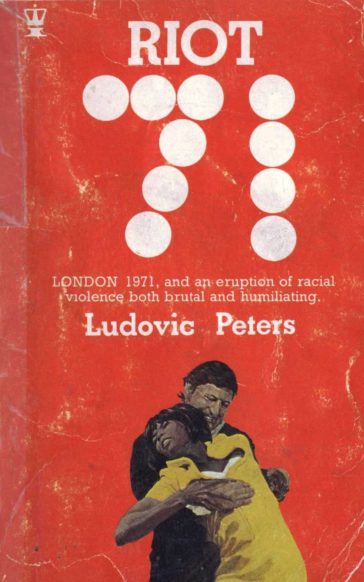 Further upsets that took place in the summer of ‘67 included the proliferation of hippies (and, by extension, illicit drug use) and the murder of two young people in New York’s East Village, which prompted the young adult novelist Maia Wojciechowska to proclaim that “Other summers will come and go but the summer of 1967 will not resemble them.” Wojciechowska further assured her youthful readers that “we shall all survive (that summer) as we have survived other disasters.” Straight America was evidently ignorant of just how wild things would get; it was, appropriately enough, a British novelist, one Ludovic Peters, who in ‘67 offered a cogent foreshadowing of things to come.
Further upsets that took place in the summer of ‘67 included the proliferation of hippies (and, by extension, illicit drug use) and the murder of two young people in New York’s East Village, which prompted the young adult novelist Maia Wojciechowska to proclaim that “Other summers will come and go but the summer of 1967 will not resemble them.” Wojciechowska further assured her youthful readers that “we shall all survive (that summer) as we have survived other disasters.” Straight America was evidently ignorant of just how wild things would get; it was, appropriately enough, a British novelist, one Ludovic Peters, who in ‘67 offered a cogent foreshadowing of things to come.
Peters’s RIOT ‘71 is far from spot-on in its prediction of the “future” year 1971, but its overall tenor, pivoting on racial tensions boiling over, would prove quite pertinent. The novel also foreshadows V FOR VENDETTA in its portrait of an England run by overtly racist, borderline fascist rulers. It’s hardly surprising that amid an official investigation into a series of murders, all bearing tell-tale signs of African mysticism, a succession of increasingly apocalyptic race riots occur that shake the nation to its core. As a mystery RIOT ’71 leaves much to be desired, but its portrayal of a country literally torn apart by racism is potent and alarming.
1969 saw the publication of SIEGE by Edwin Corley and AFRO-6 by Hank Lopez, two thrillers that contain nearly identical concepts entailing an African-American uprising that involves the blowing up of bridges and tunnels connecting New York City with the mainland. The former novel has pretentions to High Literature (with its disclaimer informing us “the story that follows may yet, in one form or another, take place”), while the latter is much pulpier, with more generous dollops of sex and violence. Both are readable and exciting, if somewhat less than plausible.
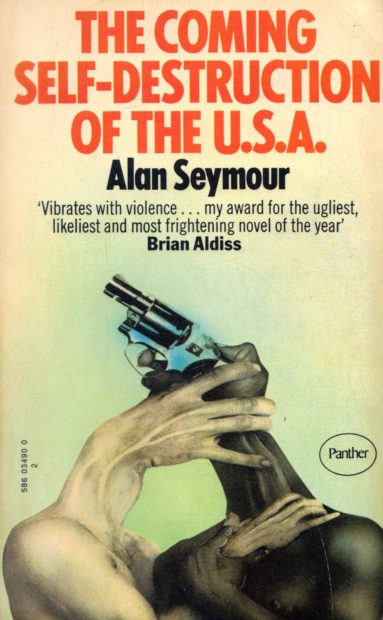 1969 also gave us THE SPOOK WHO SAT BY THE DOOR by Sam Greenlee, a convincingly detailed narrative about a black CIA agent who uses his combat expertise to recruit and train an army of freedom fighters. The novel was initially rejected by American publishers, but proved quite influential among readers and filmmakers (having inspired a well-received 1973 film adaptation and, it’s been alleged, the Symbionese Liberation Army that kidnapped Patty Hearst in 1974), and so completely overshadowed another, far more outrageous novel of black rebellion published the same year.
1969 also gave us THE SPOOK WHO SAT BY THE DOOR by Sam Greenlee, a convincingly detailed narrative about a black CIA agent who uses his combat expertise to recruit and train an army of freedom fighters. The novel was initially rejected by American publishers, but proved quite influential among readers and filmmakers (having inspired a well-received 1973 film adaptation and, it’s been alleged, the Symbionese Liberation Army that kidnapped Patty Hearst in 1974), and so completely overshadowed another, far more outrageous novel of black rebellion published the same year.
THE COMING SELF-DESTRUCTION OF THE U.S.A. was written by the Australian playwright and screenwriter Alan Seymour (1927–2015). It’s an epistolary novel consisting of letters and diary entries detailing a twenty year long black uprising that reduces America to a state of total anarchy. The insurrection is run by a shadowy individual known only as Hero, who incites violent acts that inflame the white populace, which in many cities end up becoming subservient as the black revolutionaries completely take over. Hero himself is eventually killed in the melee, and replaced by a far more ruthless revolutionary leader.
Seymour gets many things right (the “white flight” of 1960s and 70s America is very much taken into account, as is the intercession of the far right into mainstream politics), but displays an oft-naïve and simplistic depiction of race relations in the US. Yet his ability to maintain focus throughout a highly panoramic, multi-character account is salutary, especially in light of the following like-minded novel.
In 1971 MEETING THE BEAR: JOURNAL OF THE BLACK WARS by Lloyd Zimpel appeared. It can be read as something of a twin of the previous novel, which taken together form a twosome not dissimilar to that of SIEGE and AFRO-6. Once again we have a bleak portrayal of a race war that destroys America, related once again through diary entries. Here, though, those entries are all written by one person: a functionary in a government agency tasked with collecting info on the mayhem, which is threaded with the mundanities of the character’s day-to-day existence (inter-office rivalries, marital squabbles, etc.). Thus Lloyd Zimpel succeeds in establishing a sense of desperate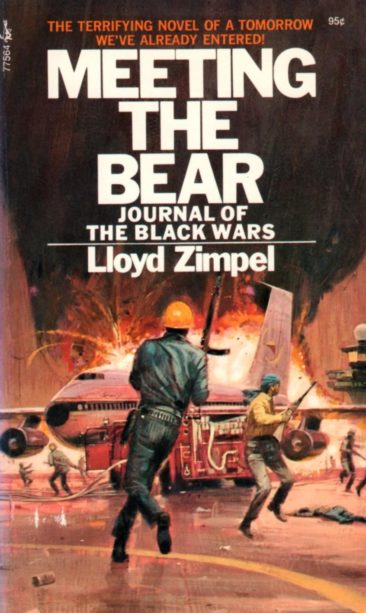 ly-clung-to normalcy amid all the chaos (something THE COMING SELF-DESTRUCTION OF THE U.S.A. misses entirely); unfortunately that sense, coupled with the nonchalant attitude the protagonist takes toward the unrest (however true-to-life that attitude may be), makes for a shockingly dull, formless reading experience that closes off this particular sub-genre in extremely uninvigorating fashion.
ly-clung-to normalcy amid all the chaos (something THE COMING SELF-DESTRUCTION OF THE U.S.A. misses entirely); unfortunately that sense, coupled with the nonchalant attitude the protagonist takes toward the unrest (however true-to-life that attitude may be), makes for a shockingly dull, formless reading experience that closes off this particular sub-genre in extremely uninvigorating fashion.
Before leaving, there are two post-Nixon era novels that need to be discussed. The first of those novels, THE TURNER DIARIES by William Luther Pierce (as “Andrew MacDonald”), can be dispensed with fairly quickly. Hailing from 1978, it’s an unabashedly racist fantasy about an Aryan-minded revolutionary looking to get the United Stated embroiled in a race war so his organization can “spread its wise and benevolent rule over the earth for all time to come”—although the actions of this outfit never seemed too wise, much less benevolent, to me. An ignorant, implausible and plain ridiculous novel whose sole points of interest are the many real-life crimes attributed to it.
PLAN B by Chester Himes (1909-1984) is deserving of a much wider discussion. It’s something of an outlier in this line-up in that it’s one of the only black uprising-themed novels discussed here that was actually written by a black man. That man, furthermore, happens to have been one of America’s greatest writers, although the never-completed PLAN B is far from his best work.
The novel was posthumously published in 1984, but written in the early 1970s. Thus it’s very much of a piece with THE COMING SELF-DESTRUCTION OF THE U.S.A. and MEETING THE BEAR, detailing yet another apocalyptic black uprising, albeit one containing a sense of profound anger far removed from the reportorial diction of its fellows. The uprising of PLAN B is kicked off by a wealthy black man who ships high-powered rifles to random black folk across the US, leading to an all-out race war that concludes with the reinstatement of slavery(!).
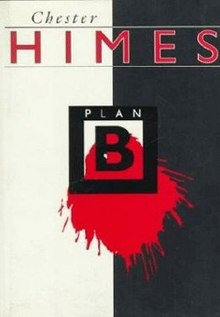 The novel has a first draft feel throughout. The prose is alternately rushed and overwrought, and the presence of Coffin Ed Johnson and Grave Digger Jones, the heroes of Himes’s Harlem Detective series, feels tacked-on. There are, however, some good things, including Himes’ adroit skewering of both white and black fallacies, and writing that is at times quite brilliant. So PLAN B may not work, but it’s by not a stiff by any means.
The novel has a first draft feel throughout. The prose is alternately rushed and overwrought, and the presence of Coffin Ed Johnson and Grave Digger Jones, the heroes of Himes’s Harlem Detective series, feels tacked-on. There are, however, some good things, including Himes’ adroit skewering of both white and black fallacies, and writing that is at times quite brilliant. So PLAN B may not work, but it’s by not a stiff by any means.
A product of its time PLAN B, like most of the rest of the novels discussed here, undeniably was. All these novels felt severely out of place in the 1970s, a time in which, in the words of the late rock ‘n’ roll impresario Danny Sugerman, “No one wanted to be inflamed, they wanted to be sedated. It’s no accident “laid-back” was the operative word of the day.” Thus PLAN B, RIOT ‘67, THE COMING SELF-DESTRUCTION OF THE U.S.A. and MEETING THE BEAR were quickly forgotten, a status that in most cases remains in effect today.
Of course, as of 2021 things are much different. The revolutionary fervor of the late sixties appears to have returned, with the idea of an apocalyptic racial uprising seeming not at all far-fetched. If anything the preceding novels (THE TURNER DIARIES aside) feel even more pertinent and prophetic than they once did. Flawed they may be, but we ignore their insights at our peril.
